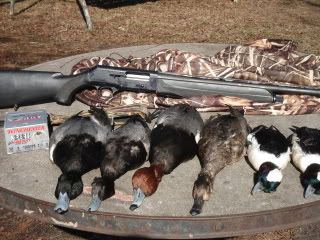I was not suggesting that anyone fire one pound or one ounce pieces of shot.
....as I took care to point out in my post, I understood it was an analogy ...... would not want to confuse folks.....
I am not a hunter, but when patterning are you only looking to see that a single pellet hits the duck drawn or enough pellets to bring one down, if more than one is usually needed?
I am looking to make sure there are not large gaps in the pattern, and there will be multiple hits in vital areas ....... most birds are not hard to kill with birdshot (turkeys being an exception-their feathers make pretty good armor, don't ask me how I know.....) all you need to have is a pattern dense enough that the vital areas you are trying to hit gets several pellets........
I don't hunt ducks, I hunt doves and turkeys ..... when patterning for doves, I want the largest pattern possible that leaves no more than about 2" between pellets at 30 yards....... for turkeys, I want a much tighter pattern ..... say, not more than 1" at 40 yards...... and any pellet outside of a 6 or 8 inch circle is wasted....... I am aiming just below the turkey's head and want to break his neck with a pellet or two.....

